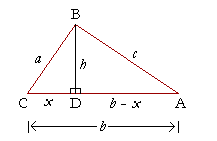Example 1. In triangle DEF, side e = 8 cm, f = 10 cm, and the angle at D is 60°. Find side d.

Solution.. We know two sides and their included angle. Therefore, according to the Law of Cosines,
d² = e² + f² − 2ef cos 60°
d² = 8² + 10² − 2· 8· 10· ½, since cos 60° = ½,
d² = 164 − 80
d² = 84.
d =  .
.
Problem 1. In the oblique triangle ABC, find side b if side a = 5 cm, c =  cm, and they include and angle of 45°. No Tables.
cm, and they include and angle of 45°. No Tables.

To see the answer, pass your mouse over the colored area.
To cover the answer again, click "Refresh" ("Reload").
b² = a² + c² − 2ac cos 45°
= 5² + ( )² − 2· 5·
)² − 2· 5·  · cos 45°
· cos 45°
= 25 + 2 − 10·  ·
½
·
½ , since cos 45° = ½
, since cos 45° = ½ ,
,
= 25 + 2 − 10, ( ·
·  = 2)
= 2)
= 17.
b
=  cm.
cm.
Problem 2. In the oblique triangle PQR, find side r if side p = 5 in, q = 10 in, and they include and angle of 14°. (Table)

r² = 5² + 10² − 2· 5· 10 cos 14°
= 25 + 100 − 100(.970), from the Table.
= 125 − 97
= 28.
r
=  in.
in.
Example 2. In Example 1, we found that d =  , which is approximately 9.17.
, which is approximately 9.17.

Use the Law of Sines to complete the solution of triangle DEF. That is, find angles E and F.
And so using the Laws of Sines and Cosines, we have completely solved the triangle.
Proof of the Law of Cosines

Let ABC be a triangle with sides a, b, c. We will show
c² = a² + b² − 2ab cos C.
Draw BD perpendicular to CA, separating triangle ABC into the two right triangles BDC, BDA. BD is the height h of triangle ABC.
Call CD x. Then DA is the whole b minus the segment x: b − x.
Also, since
x = a cos C . . . . . . . (1)
Now, in the right triangle BDC, according to the Pythagorean theorem,
h² + x² = a²,
so that
h² = a² − x². . . . . . (2)
In the right triangle BDA,
c² = h² + (b − x)²
c² = h² + b² − 2bx + x².
(The square of a binomial)
For h², let us substitute line (2):
c² = a² − x² + b² − 2bx + x²
c² = a² + b² − 2bx.
Finally, for x, let us substitute line (1):
c² = a² + b² − 2b· a cos C.
That is,
c² = a² + b² − 2ab cos C.
This is what we wanted to prove.
In the same way, we could prove that
a² = b² + c² − 2bc cos A
and
b² = a² + c² − 2ac cos B.
This is the Law of Cosines.
Next Topic: The Circle
The Topics | Home
www.proyectosalonhogar.com